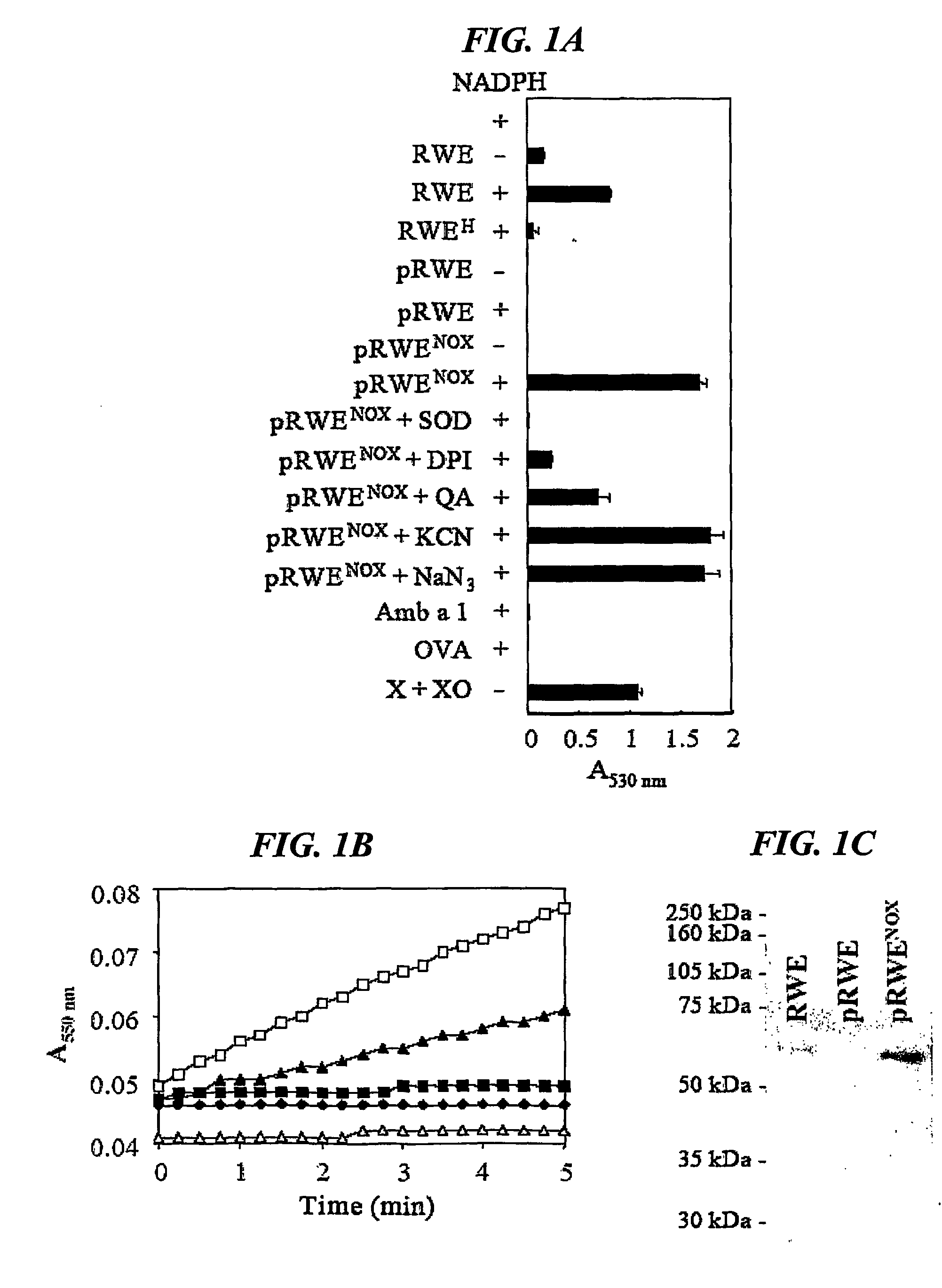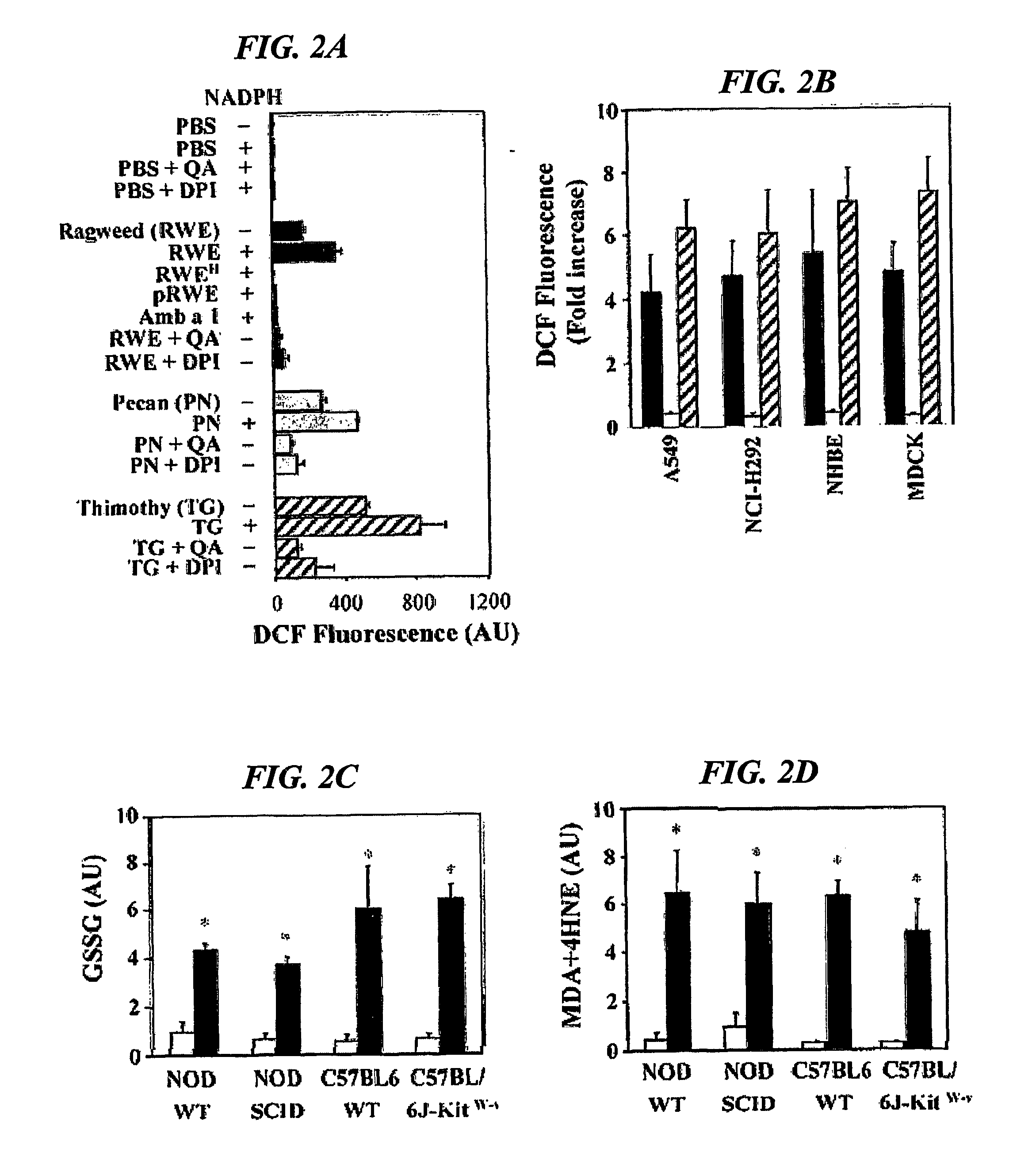Methods for inhibiting allergic inflammation and other responses initiated by pollens, molds, and other non-animal derived allergens
a non-animal derived allergen and allergic inflammation technology, which is applied in the field of inhibiting allergic inflammation and other responses initiated by pollens, molds, and other non-animal derived allergens, can solve the problems of asthma reactions, major and growing medical problems, and the ability of non-animal derived allergens to inhibit allergic inflammation and other responses
- Summary
- Abstract
- Description
- Claims
- Application Information
AI Technical Summary
Benefits of technology
Problems solved by technology
Method used
Image
Examples
example 1
Overview of the Studies Described in Examples 2-6
[0054] In this Example 1 and in the following Examples 2-6, numerals in square brackets refer to references that are set forth in Example 7. Each of these references is hereby incorporated by reference.
[0055] Asthma is an inflammatory disease of the airways that is associated with oxidative stress generated by inflammatory cells recruited to the airways after exposure to allergens [1-4]. An unresolved question is whether enzymatic activities in pollens directly induce oxidative stress prior to inflammation. Plant cells have NADPH oxidases that are similar to the inducible NADPH oxidase complex in the plasma membrane of mammalian phagocytes [5-7]. These plant oxidases play a critical role in vital physiological functions, including defense against pathogens [6,8], growth and development [7,9]. A recent study has demonstrated that reactive oxygen species (“ROS”) produced by NADPH oxidases regulate expansion of cells in root hairs [10]...
example 2
All Tested Pollens Possess Intrinsic NADPH Oxidase Activity
[0056] We show here that ragweed (Ambrosia artemisiifolia) pollen extract (“RWE”) effectively reduces nitroblue tetrazolium (“NBT”) to formazan (FIG. 1A), suggesting that it generates superoxide anions (O2.−). Adding NADPH to RWE boosted NBT reduction (FIG. 1A), implying that RWE contains NADPH dependent oxidases. To accurately quantify formazan in an NBT assay, we separated pigments from RWE by Superdex 200 filtration. Because filtration also separates substrates from enzymes, none of the pigment-free fractions reduced NBT. Adding NADPH to the fractions reconstituted the ability of some fractions to reduce NBT. These NBT-reactive (pRWENOX) and the NBT non-reactive (pRWE) fractions were pooled separately. The NBT reducing activity of pRWENOX was inhibited by NADPH oxidase inhibitors diphenyleneiodonium and quinacrine [12], but was resistant to the respiratory inhibitors cyanide and azide [7] (FIG. 1A). These observations su...
example 3
NADPH Oxidases Intrinsic to Pollens Induce Oxidative Stress in Cultured Cells and Lungs
[0058] Next, we examined the effects of pollen extracts on cultured epithelial cells and in the lungs of mice. RWE, pecan tree and timothy grass pollen extracts all converted the intracellular redox-sensitive 2′,7′-dihydro-dichlorofluorescein diacetate (H2DCF-DA) in confluent, cultured normal human bronchial epithelial (“NHBE”) cells into fluorescent dichlorofluorescin (FIG. 2A). RWE also increased intracellular ROS levels in NHBE cells grown in air-liquid interface [21] (data not shown) and in other lung-(NCI-H292) and kidney-(MDCK) derived epithelial cells (FIG. 2B). Elevation in ROS levels was inhibited by NADPH oxidase inhibitors diphenyleneiodonium and quinacrine [12] (FIG. 2A), and also by pre-treating cells with the antioxidant N-acetyl-L-cysteine (“NAC”) [22] (FIG. 2B). Consistent with their lack of NADPH oxidase activity, RWEH, pRWE, and Amb a 1 failed to change the cellular redox state ...
PUM
| Property | Measurement | Unit |
|---|---|---|
| size | aaaaa | aaaaa |
| volume | aaaaa | aaaaa |
| volume | aaaaa | aaaaa |
Abstract
Description
Claims
Application Information
 Login to View More
Login to View More - R&D
- Intellectual Property
- Life Sciences
- Materials
- Tech Scout
- Unparalleled Data Quality
- Higher Quality Content
- 60% Fewer Hallucinations
Browse by: Latest US Patents, China's latest patents, Technical Efficacy Thesaurus, Application Domain, Technology Topic, Popular Technical Reports.
© 2025 PatSnap. All rights reserved.Legal|Privacy policy|Modern Slavery Act Transparency Statement|Sitemap|About US| Contact US: help@patsnap.com



